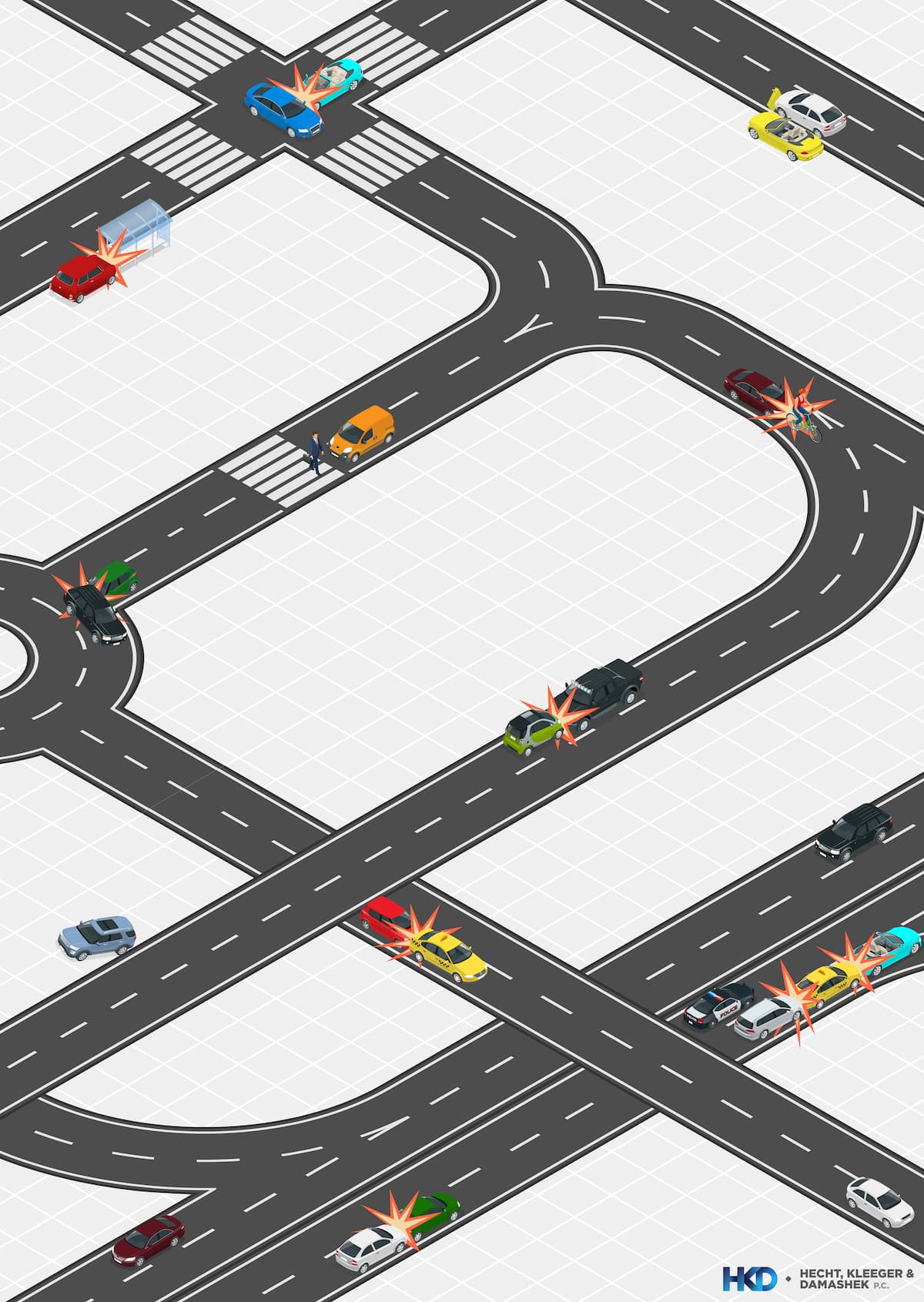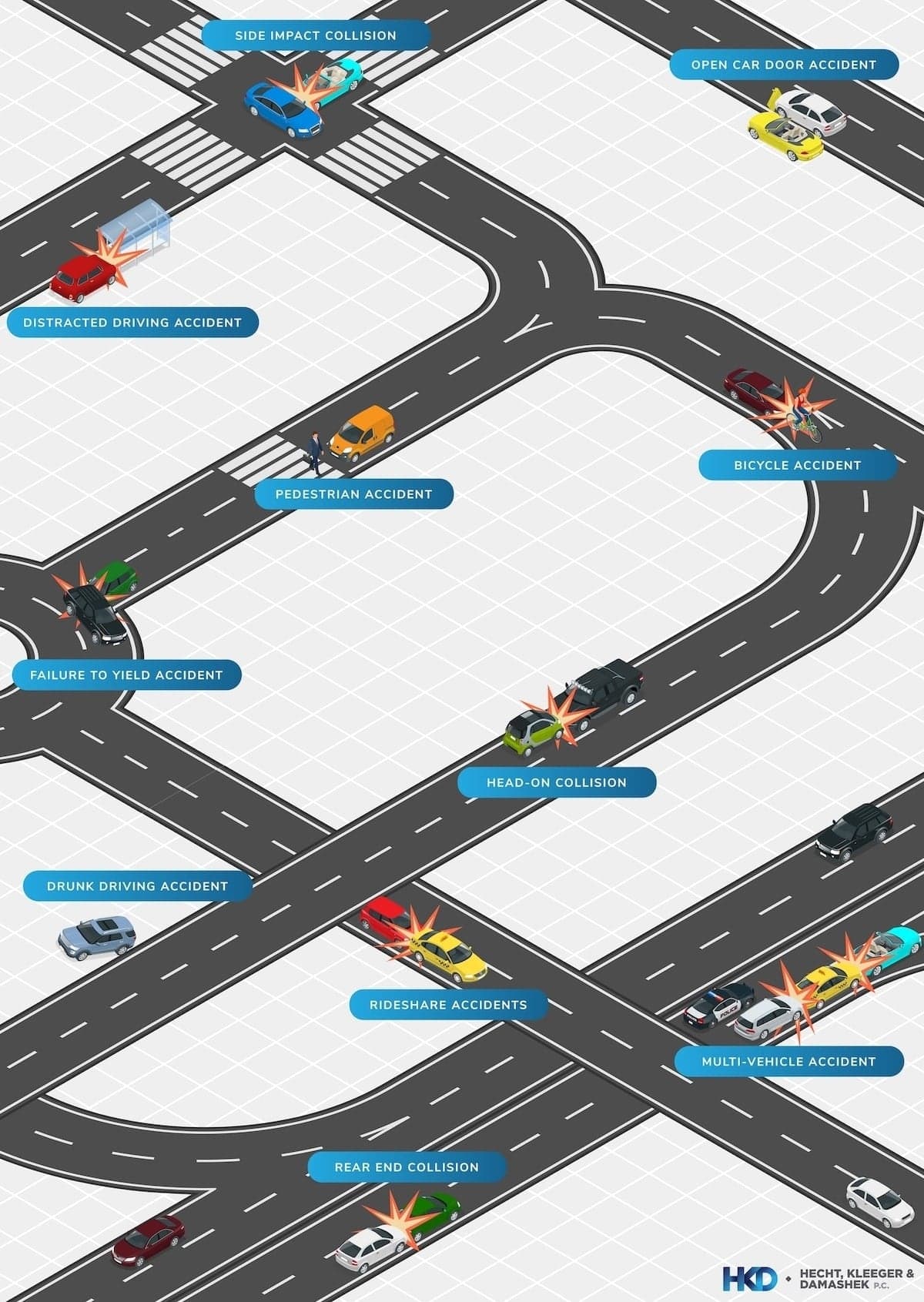

One of the first things many people do after a car accident is start pointing fingers. No one wants to be at fault because that’s who’s insurance company will have to pay for the damages. Here are some of the ways to determine who’s at fault for a car accident. Contact Hecht, Kleeger & Damashek P.C. with any further questions you might have.
Proving Liability in a New York City Car Accident
While car accidents and injuries will always be unique, and although claims will always vary, the fact remains that injured victims deserve to be fairly compensated. In order for victims of car accidents to have a fighting chance for the compensation they rightfully deserve, they must prove several important legal elements – including negligence, fault, and liability.
By focusing our efforts on establishing fault and liability, our legal team can work toward securing fair compensation on behalf of our clients. We do so by focusing on proving the following:
- Another party had a duty to keep you free from preventable harm. For example, motorists are required to take reasonable measures to drive safely and keep others free from preventable harm. Auto part manufacturers are required to ensure that their products are safe for their intended use. These are legal duties.
- This party failed to uphold their duty. For example, drivers who commit an act of negligence (such as drunk driving) fail to uphold their duty to drive safely.
- This failure caused harm. Failures to uphold duty caused preventable harm.
- You suffered damages as a result. Victims suffer physical, emotional, and / or financial damages as a direct result of the accident.
Who’s at Fault in a Failure to Yield Accident?
When a failure to yield accident happens, the person at fault is generally the individual who didn’t follow the rules of the road, posted street signs, or traffic lights. The at-fault party may be the driver of a vehicle that failed to stop at a stop sign and allow other cars to go first. An at-fault party may even be a car that failed to yield right of way to a pedestrian crossing the road in a crosswalk and had a walk signal.
To determine who was at fault in a failure to yield accident, you must first evaluate who violated the law and which individual had the right of way.
Who’s at Fault in a Head-On Collision?
In a head-on collision, the at-fault party is the driver who veered into oncoming traffic or swerved into the wrong lane. If the accident happened at an intersection, the driver at fault would be the individual who failed to follow laws or road signs indicating who should go first.
Head-on collisions are often the result of driving while intoxicated when the at-fault driver swerves across the middle yellow line. Drivers who fail to take proper care in inclement weather would be at fault, even if snow, ice, fog, or other conditions resulted in the head-on crash.
Victims of head-on collisions often suffer severe injuries because of the sudden jolt of a frontal impact and airbag deployment.
Who’s at Fault in a Rear-End Collision?
In most cases, the person responsible for a rear-end collision is the car at the very end of a crash. Legally, drivers should ensure enough space between their vehicle and the vehicle in front of them. This applies to inclement weather situations and when the car in front stops quickly.
If the roads are slick from ice or rain, drivers should make sure there is extra space between their cars and the cars in front of them to prevent a rear-end collision.
There are some exceptions, such as when a car hits a driver from behind and then pushes that car into another car in front of them. The middle car would not likely be held accountable for the rear-end collision that the car behind it forced.
Who’s at Fault in a Distracted Driving Accident?
The fault in a distracted driving accident always lies with the driver who was distracted at the time of the collision. Distracted driving may happen because someone is texting while driving or undertaking other activities when they should be paying attention to the road.
Other common distractions include eating, putting on makeup, adjusting the radio or GPS, talking to passengers, or looking at social media on an electronic device.
It can be hard to prove distracted driving, so it’s essential to work with a lawyer who can review phone records, traffic cameras, police reports and talk to eyewitnesses who may have seen something important.
Who’s at Fault in a Side Impact Collision?
A side-impact collision, also called a sideswipe accident, is the person’s fault who violates a law or swerves out of their lane into another car. This often happens on two-lane roads or highways when a driver attempts to switch lanes.
Illegal lane changes may happen when a driver fails to see the other car in their blind spot or doesn’t even look beside them. Side impact motorcycle accidents often happen when a motor vehicle driver fails to look out properly.
Car Accidents
Who’s at Fault in a Multi-Vehicle Accident?
Fault in a multi-vehicle accident is determined on a case-by-case basis. Many factors must be considered. If a car hits someone from behind and pushes that car into another car in front, then the vehicle at the very end of the accident is likely at fault.
However, more than one driver can be at fault. If cars are at an intersection and three cars advance through the intersection and a crash occurs, more than one person may blame.
Who’s at Fault in a Pedestrian Accident?
In many cases, the driver who hits the pedestrian is at fault; however, that is not always the case. There are situations where the pedestrian may be to blame. For example, if the pedestrian jaywalked or ran out in front of a car, the driver may not be responsible.
While drivers should always be on the lookout for pedestrians, avoiding accidents is not always possible. You and your lawyer will need to review the police report, traffic cameras, and eyewitness statements.
Who’s at Fault in a Bicycle Accident?
Bicycles are all over New York City, so it’s important to understand the rules of the road when they involve interaction between bicycles and cars. Bicycles must follow many of the same laws as motor vehicles in NYC. However, there are special bicycle lanes on many downtown streets.
Bicycle accidents often happen when cars or bicycles make an illegal turn and impact one another. A car may also swerve into the bike lane without seeing a cyclist.
Who’s at Fault in Rideshare Accidents?
When a rideshare accident occurs, it’s important to know your rights. If the Uber or Lyft driver is on the clock or currently working, they are covered by a large insurance policy provided by the rideshare company.
Uber and Lyft cover their drivers with a minimum of $1 million for accidents. However, drivers also have personal insurance policies that cover when they’re not working. Whether you were riding in an Uber or Lyft or a rideshare driver hit your car, you have options for how to recover compensation.
Who’s at Fault in a Drunk Driving Accident?
The drunk driver is always violating the law. Thus, even if they did not directly cause a drunk driving accident, they may be partially to blame. Whether there was a multi-car accident or you are partially to blame, a drunk driver will be cited with a criminal offense that can be used to prove fault.
Drinking while driving serious impairs a driver’s ability to react to dangerous situations. If an accident is about to occur, a drunk driver is less likely to respond properly to avoid it. In nearly all situations, the drunk driver will be found to be partially or totally at fault for an accident.
Who’s at Fault in an Open Car Door Accident?
When a motor vehicle, bicyclist, or other vehicle hits an open car door, the person who opened the car door is almost always at fault. Although a car may legally stop on the side of a road, they must be watchful of their surroundings when opening the car door.
It is the person’s responsibility inside the vehicle to ensure it is safe to open the car door. Open car door accidents can be particularly dangerous for motorcycles and bicyclists. If this happens to you, you should immediately reach out to a lawyer to begin an insurance claim.
HKD Can Help Determine Who’s At Fault
If you were involved in a car accident in New York City, you are probably wondering who is responsible for paying for the damage. With millions recovered for past clients, the New York City car accident lawyers at Hecht, Kleeger & Damashek can help you determine precisely what happened and how to file a car accident claim.
Call 212-490-5700 or use our contact form for a free consultation. There’s no fee unless we win.
CLIENT REVIEWS

10/15/2021
I have had two cases with Hecht, Kleeger & Damashek and have had great results! I have netted over seven figures and would recommend the firm anyone who has been injured in a slip and fall or auto accident.
12/09/2020
My family and I hired Hecht, Kleeger & Damashek to represent us with regards to a car accident case. We were very impressed with the level of attention we received from Jonathan Damashek. They were able to secure a very…
07/05/2015
After meeting a half dozen lawyers at different firms, I decided to go to Hecht, Kleeger and Damashek. As soon as I met Jon Damashek, I knew I had to look no further. Mr. Damashek made me feel at ease…